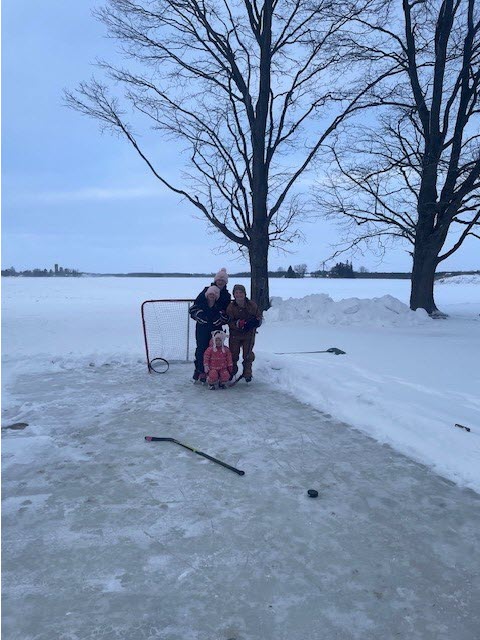Rink builders discuss the ice and its significance to their families
By Diego Flammini
Staff Writer
Farms.com
Winter is outdoor rink season across Canada, and Ontario farm families are partaking in the tradition of flooding a sheet of ice for kids and adults alike to enjoy.
For some families, like the Frasers, who operate a dairy farm north of Embro, Ont., this winter marks the inaugural season of their outdoor arena.
“I’m sure the lockdown inspired my husband Kris a little bit more to get one going,” Laura Fraser told Farms.com. “For us, hockey has always been a source of entertainment and family time.”
The Frasers have four daughters, three of whom play hockey.
But COVID-19 restrictions mean community rinks are closed and ice time is hard to come by.
The Fraser girls have been spending countless hours on the ice, Laura said.

The Fraser girls (Eden, Whitney, Mia and Esme) on their homemade ice rink. (Laura Fraser photo)
“They’re really missing their organized hockey, so they really love the outdoor rink,” she said. “They’ll finish their chores, run inside to get their skates on and spend the day playing together on the ice.”
The Frasers have been taking notes during the season on how to improve the rink for next winter.
“It’s a small rink and it’s been a learning curve for us, but I think next year it’ll be bigger and better,” Laura said.
Other families have a little more experience in the rink-making department.
Craig McGill, co-owner of McGill Fairfield Farm Drainage in Pontypool, Ont., has worked with his brother Mark to convert a covered barn into an indoor rink for the past four years.
“The barn was used for machinery which we sold during an auction a few years ago,” Craig told Farms.com. “Having a covered structure makes it easier for the kids to play.”

The McGills line the ice with 2x6s and sheets of plywood for rink boards on the 40ft. by 40 ft. (12m x 12m) sheet of ice.
While the covered structure protects players from the elements, it does have a few drawbacks.
“It takes longer to make the rink because it stays warmer in the barn,” he said. “The challenge is trying to get good ice and get it frozen enough this year to skate on. It’s a lot of hard work but it’s so great when it comes to fruition and you see how happy the kids are to have somewhere to play.”
The Jacksons are another family who have built an outdoor rink on their family farm.
Matt Jackson, who farms about 250 acres of cash crops near Woodville, Ont., has added small improvements to the 40ft. by 70ft. (12m by 21m) rink each of the past few years.
“It looks a little funny but this year we used pallet skids as boards,” he told Farms.com. “We drove fence posts down around the outside of the rink and put the skids overtop.”

Matt Jackson's ice rink (Matt Jackson photo)
During normal winters, the Jackson rink is where 10 to 15 families gather to spend time with one another and watch the kids play on the ice.
“It didn’t matter if you had skates on or not, everyone was involved and played together,” Jackson said. “The rink serves well for our kids who are four and five, all the way up to my father and grandfather in their 70s and 80s who like to pass the puck around from time to time or just sit and watch the kids.”
The amateur rink builder also shared a piece of advice for others looking to build a home rink.
“Flood the ice in thin layers so it freezes faster,” he said. “The more water you’re trying to freeze, the longer it’s going to take.”